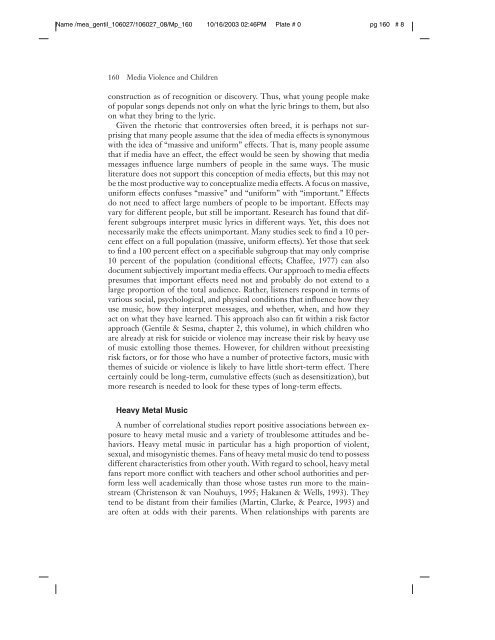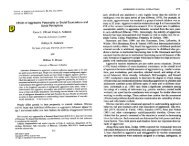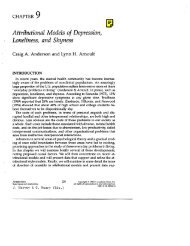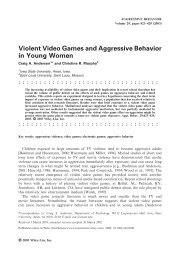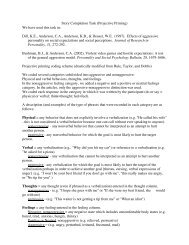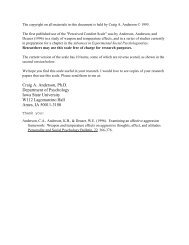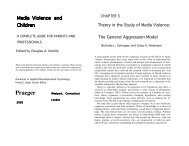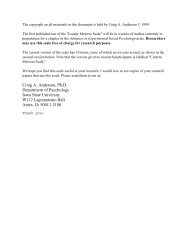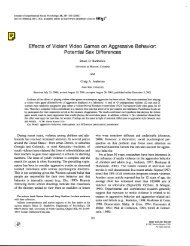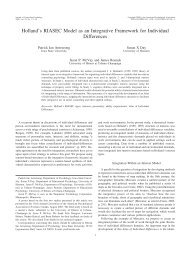The Effects of Violent Music on Children and Adolescents
The Effects of Violent Music on Children and Adolescents
The Effects of Violent Music on Children and Adolescents
Create successful ePaper yourself
Turn your PDF publications into a flip-book with our unique Google optimized e-Paper software.
Name /mea_gentil_106027/106027_08/Mp_160 10/16/2003 02:46PM Plate # 0 pg 160 # 8<br />
160 Media Violence <strong>and</strong> <strong>Children</strong><br />
c<strong>on</strong>structi<strong>on</strong> as <str<strong>on</strong>g>of</str<strong>on</strong>g> recogniti<strong>on</strong> or discovery. Thus, what young people make<br />
<str<strong>on</strong>g>of</str<strong>on</strong>g> popular s<strong>on</strong>gs depends not <strong>on</strong>ly <strong>on</strong> what the lyric brings to them, but also<br />
<strong>on</strong> what they bring to the lyric.<br />
Given the rhetoric that c<strong>on</strong>troversies <str<strong>on</strong>g>of</str<strong>on</strong>g>ten breed, it is perhaps not surprising<br />
that many people assume that the idea <str<strong>on</strong>g>of</str<strong>on</strong>g> media effects is syn<strong>on</strong>ymous<br />
with the idea <str<strong>on</strong>g>of</str<strong>on</strong>g> “massive <strong>and</strong> uniform” effects. That is, many people assume<br />
that if media have an effect, the effect would be seen by showing that media<br />
messages influence large numbers <str<strong>on</strong>g>of</str<strong>on</strong>g> people in the same ways. <str<strong>on</strong>g>The</str<strong>on</strong>g> music<br />
literature does not support this c<strong>on</strong>cepti<strong>on</strong> <str<strong>on</strong>g>of</str<strong>on</strong>g> media effects, but this may not<br />
be the most productive way to c<strong>on</strong>ceptualize media effects. A focus <strong>on</strong> massive,<br />
uniform effects c<strong>on</strong>fuses “massive” <strong>and</strong> “uniform” with “important.” <str<strong>on</strong>g>Effects</str<strong>on</strong>g><br />
do not need to affect large numbers <str<strong>on</strong>g>of</str<strong>on</strong>g> people to be important. <str<strong>on</strong>g>Effects</str<strong>on</strong>g> may<br />
vary for different people, but still be important. Research has found that different<br />
subgroups interpret music lyrics in different ways. Yet, this does not<br />
necessarily make the effects unimportant. Many studies seek to find a 10 percent<br />
effect <strong>on</strong> a full populati<strong>on</strong> (massive, uniform effects). Yet those that seek<br />
to find a 100 percent effect <strong>on</strong> a specifiable subgroup that may <strong>on</strong>ly comprise<br />
10 percent <str<strong>on</strong>g>of</str<strong>on</strong>g> the populati<strong>on</strong> (c<strong>on</strong>diti<strong>on</strong>al effects; Chaffee, 1977) can also<br />
document subjectively important media effects. Our approach to media effects<br />
presumes that important effects need not <strong>and</strong> probably do not extend to a<br />
large proporti<strong>on</strong> <str<strong>on</strong>g>of</str<strong>on</strong>g> the total audience. Rather, listeners resp<strong>on</strong>d in terms <str<strong>on</strong>g>of</str<strong>on</strong>g><br />
various social, psychological, <strong>and</strong> physical c<strong>on</strong>diti<strong>on</strong>s that influence how they<br />
use music, how they interpret messages, <strong>and</strong> whether, when, <strong>and</strong> how they<br />
act <strong>on</strong> what they have learned. This approach also can fit within a risk factor<br />
approach (Gentile & Sesma, chapter 2, this volume), in which children who<br />
are already at risk for suicide or violence may increase their risk by heavy use<br />
<str<strong>on</strong>g>of</str<strong>on</strong>g> music extolling those themes. However, for children without preexisting<br />
risk factors, or for those who have a number <str<strong>on</strong>g>of</str<strong>on</strong>g> protective factors, music with<br />
themes <str<strong>on</strong>g>of</str<strong>on</strong>g> suicide or violence is likely to have little short-term effect. <str<strong>on</strong>g>The</str<strong>on</strong>g>re<br />
certainly could be l<strong>on</strong>g-term, cumulative effects (such as desensitizati<strong>on</strong>), but<br />
more research is needed to look for these types <str<strong>on</strong>g>of</str<strong>on</strong>g> l<strong>on</strong>g-term effects.<br />
Heavy Metal <str<strong>on</strong>g>Music</str<strong>on</strong>g><br />
A number <str<strong>on</strong>g>of</str<strong>on</strong>g> correlati<strong>on</strong>al studies report positive associati<strong>on</strong>s between exposure<br />
to heavy metal music <strong>and</strong> a variety <str<strong>on</strong>g>of</str<strong>on</strong>g> troublesome attitudes <strong>and</strong> behaviors.<br />
Heavy metal music in particular has a high proporti<strong>on</strong> <str<strong>on</strong>g>of</str<strong>on</strong>g> violent,<br />
sexual, <strong>and</strong> misogynistic themes. Fans <str<strong>on</strong>g>of</str<strong>on</strong>g> heavy metal music do tend to possess<br />
different characteristics from other youth. With regard to school, heavy metal<br />
fans report more c<strong>on</strong>flict with teachers <strong>and</strong> other school authorities <strong>and</strong> perform<br />
less well academically than those whose tastes run more to the mainstream<br />
(Christens<strong>on</strong> & van Nouhuys, 1995; Hakanen & Wells, 1993). <str<strong>on</strong>g>The</str<strong>on</strong>g>y<br />
tend to be distant from their families (Martin, Clarke, & Pearce, 1993) <strong>and</strong><br />
are <str<strong>on</strong>g>of</str<strong>on</strong>g>ten at odds with their parents. When relati<strong>on</strong>ships with parents are


